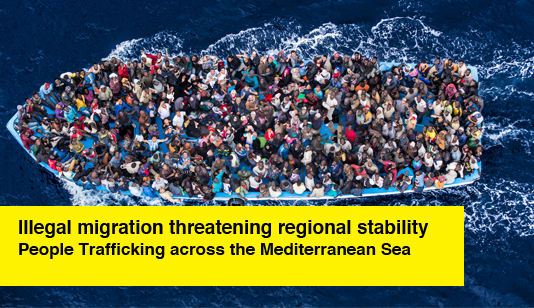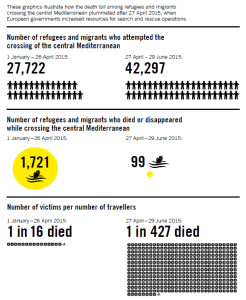Illegal migration threatening regional stability
People Trafficking across the Mediterranean Sea
by Annemarie Robson\ International Editor
Regional unrest in the Middle East – whether caused by the lack of stable and democratic government, civil war, or incursions by the Taliban or Da’esh* – is impacting not only upon those living in the MENA region, but millions of people living across Europe. The greatest stress falls upon those countries bordering the Mediterranean Sea, such as Turkey, Greece and Italy.
In this first of a two-part feature, Annemarie Robson shows how the issue has arisen and how it is being handled. In our next issue, we will look at the situation through the eyes of migrants, and try to understand why people risk everything to reach Europe.
This article aims to focus on the people involved – the migrants themselves who risk all to flee their home countries and the citizens of European Union (EU) countries dealing with the influx of refugees.
*Photo by © Massimo Sestini
What is migration?
According to the Oxford English Dictionary, the definition of migration is the ‘movement of people to a new area or country in order to find work or better living conditions’.
It is paradoxical that whilst migration is the most natural thing in the world for people to do, it is viewed in a negative way by many people. Most people want to get on in life and help their family thrive and feel that they will be happier finding a new place to live. Let’s not forget, migration is how all civilisations came into being; if the first humans had simply stayed where they were born and not wanted to discover new things, today’s world would be a very different place. We definitely wouldn’t have the diversity of languages, cultures and race that we have today, and many of the amazing achievements in science and technology, literature, art and music would never have occurred.
However, this current wave of migration – and I’m focusing on the illegal, uncontrolled and officially named ‘irregular migration’ – is like a giant lethal octopus spreading its deadly tentacles across the Bosphorous (with Syrian and Iraqi refugees fleeing through Turkey) and beyond, with African and other Middle Eastern refugees taking their lives in their hands by trying to cross the Mediterranean towards Europe and the new life they dream of.
The only winners right now are the people traffickers and those involved with organised crime who are taking advantage of those desperate to leave the region. Migrants who pay to be smuggled into Europe must be disappointed. After paying massive fees to be transported in conditions that are often unfit for animals, let alone humans, suffer long, dangerous journeys, more often than not now languish in detention centres, migrant camps, find themselves sleeping rough or in hostels for the homeless. Reports on TV in Europe show people going for days without food and trying to wash clothes in puddles – not exactly the ‘better life’ in Europe they sought.
For those who have fled that most vicious of civil wars in Syria, ending up a refugee in Lebanon is a well-travelled route. One quarter of Lebanon’s population is a refugee – predominantly coming from Syria, Iraq or Palestine.
From the European point-of-view
Apart from the crisis surrounding the potential ‘Grexit’ – Greece defaulting on its IMF loans and potentially exiting the Euro – the flow of people seems to be non-stop and the resultant death and ensuing chaos takes up more column inches and hours of news reporting than any other current issue.
EU Frontex, the EU’s border agency, recently published its risk summary concerning the illegal border crossings across Europe for last year, 2014. In the report, it says:
“Detections of illegal border-crossing reached a new record, with more than 280,000 detections. The unprecedented number of migrants crossing illegally crossing the external borders has roots in the fighting in Syria that has resulted in the worst refugee crisis since the Second World War”.
Most migrants, it seems, have been detected during the ongoing search and rescue operations within the Mediterranean. Many migrants have perished at sea due to the unseaworthy vessels the illegal people smugglers have been using to ship people across the unforgiving Mediterranean Sea in often inhumane, and overloaded, conditions. Thousands more may have made it through undetected, or sadly perished en route.
Distressing images started appearing on European TV screens early last year of the small islands off Italy, Lampedusa. Even Malta and the Greek island of Corfu have seen migrants washed ashore, sometimes alive, often dying or already dead. Italian charities, then the Italian Government, called for international assistance to deal with the ongoing tsunami of men (mostly), women and many children (sometimes travelling alone) who have travelled thousands of miles to make it to the EU. Many claim asylum as soon as they are rescued.
With record numbers of migrants crossing the borders illegally, resources are directed to their immediate physical well-being, rather than official screening. In many cases, once rescued, they continue their journey to other EU member states; most head for Germany, Sweden and the UK. Those choosing the UK route have yet another perilous journey to cross the English Channel in containers, secreted in lorries (whose drivers are fined if migrants are found onboard) or – most dangerously – trying to pass through the Channel Tunnel on foot or on cargo trains. Many die doing so – in July alone two migrants died trying to get through the tunnel by electrocution.
However, for EU Frontex, not knowing ‘who is where’ is threatening EU internal security at times when other issues (such as EU citizens returning from fighting in either Syria or Iraq) place immense strain upon its resources.
In 2014, most migrants were detected in the Central Mediterranean area, with detections totalling over 170,000, then on the Eastern Mediterranean with over 50,800. Towards the end of 2014, detections sharply increased at the Hungarian land border with Serbia, making the Western Balkan route (with 43,357 detections) the third most important irregular migration route towards the EU.
As for out at sea, fatalities have been extremely high. According to Amnesty International, a global human rights NGO, measures introduced by the EU in April 2015 to strengthen search and rescue capacity in the central Mediterranean, following the closure of Italy’s Operation Mare Nostrum at the end of 2014, have resulted in a significant decrease in the death rate of migrants and refugees taking this perilous route into Europe. While 1 in 16 people attempting the crossing in the first few months of 2015 lost their lives, the death rate has plummeted to 1 in 427 since the measures agreed at an emergency summit of EU leaders on 23 April started to come into effect.
There have also been efforts to stem the influx of migrants across land routes. Recent news stories have reported countries in the Balkan area wishing to install a barrier between Serbia and Hungary to try to make the route less attractive. But walls are not the answer – a solution to the core problems causing people to flee their homes in the first place is the only way forward.
Looking to the future
In the next few months, it is expected that the EU will throw all of its available resources at the situation, trying to reduce significantly the numbers of migrants reaching its shores. Now that deaths/tragedies at sea have decreased, the next target will be to look at where the migrants are leaving from, and collecting intelligence about the smugglers. These groups will then become its target, to try to stop the flow at its various sources, rather than having to deal with migrants once they reach the shores of the EU.





























